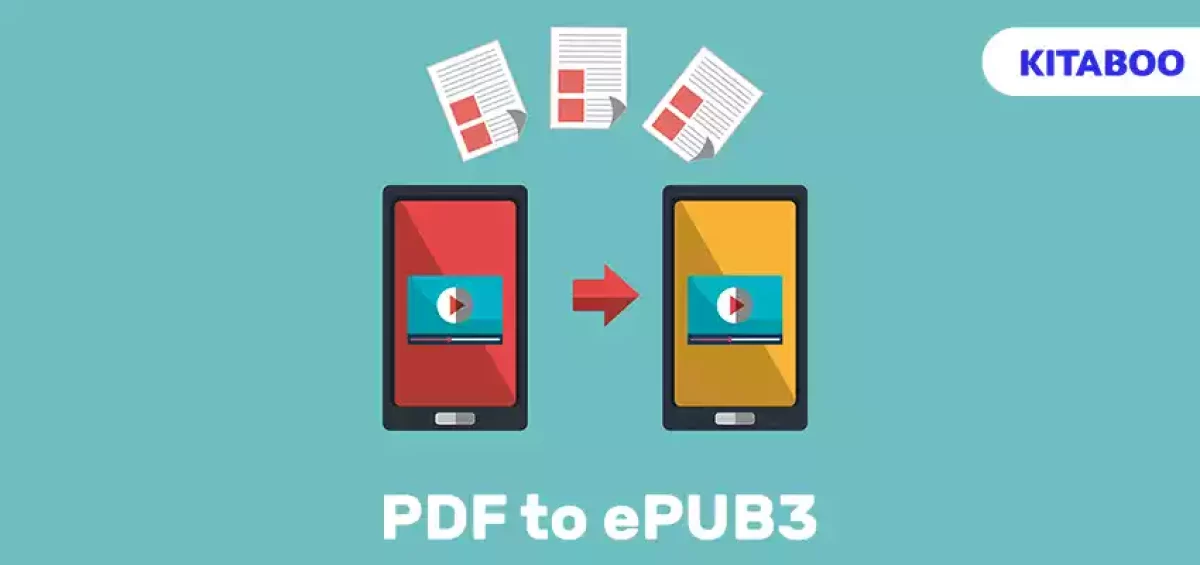The digital revolution has transformed the way information is consumed. The emergence of fixed layout and reflowable ePUB versions across industries plays an integral role in determining the success or failure of eBooks.
Just as crucial as crafting compelling content using appropriate fonts and color schemes, the layout design dictates the elements within the eBook. A well-designed eBook entices, captivates, and creates a lasting impression on readers.
An eBook layout serves as a visual representation of the content; therefore, selecting the right layout format is paramount. The choice between ePub fixed layouts and reflowable layouts influences how readers experience content.
ePUB is one of the best file formats for eBooks. Before converting a manuscript or PDF into an eBook, it is imperative to decide the most suitable layout for the content. Another critical factor to consider is choosing the best digital textbook platform, like KITABOO, to process PDF to ePUB3 conversion automation.
Let us dive deeper into the meaning and significance of fixed and reflowable layouts!
Table of Contents:
I. Meaning and Significance of Fixed Layout ePUB
II. Meaning and Significance of Reflowable Layout ePUB3 Format
III. Distinguishing Reflowable and Fixed Layout eBooks
IV. Guide to Converting PDF to Fixed Layout ePUB3 Formatting
Meaning and Significance of Fixed Layout ePUB
Undoubtedly, the majority of eBooks adopt a reflowable format. However, with the high demand for interactive and intricate content, the use of fixed layout eBooks is indispensable. Its key features are:
- A fixed layout ePUB eBook is like the print version of a book in which:
- The page dimensions are predefined
- The display size remains consistent regardless of the screen it is viewed on.
- Typeface and font size are generally fixed
- The text displays are uniform
- Interactive and multimedia features can supplement text and other elements.
Advantages of Fixed Layout ePUB
- The fixed layout ePUB is best used for K12 learning and higher education eBooks, graphic story books and novels, comics, illustrative books like food recipe books, and children’s picture books. It encourages a simultaneous viewing of text and images.
- This is a feature that reflowable eBooks cannot fulfill. Reflowable eBooks are used best for the cohesion of text and images. However, for extreme conditions like screen size limitations or user-defined text preferences, the fixed layout eBook serves the best purpose.
- Similar to PDFs, fixed-layout eBooks offer a uniform reading experience across different platforms. However, unlike PDFs, fixed-layout eBooks retain the flexibility of ePub files. In circumstances where readers enlarge the text significantly, text-overflow onto the next pages may occur, which ultimately offers a perfect reading experience.
Disadvantages of Fixed Layout ePUB
- One significant disadvantage is the inherent inflexibility of fixed-layout eBooks across different reading platforms.
- It poses challenges in scenarios where content is designed for larger screens. It converts to a two-page spread, which can compromise readability, especially on smartphones.
- Another notable drawback is the limited acceptance of fixed-layout eBooks.
- Lastly, the process of creating fixed-layout eBooks remains complex and time-consuming.
However, despite these challenges, fixed layout ePUB eBooks may still be the preferred format for certain publications.
Meaning and Significance of Reflowable Layout ePUB3 Format
Reflowable layout is all about adjusting content to accommodate various screen sizes. It is widely adopted for eBooks and effectively adapts to different mobile devices. It is a preferred choice for digital publications.
A reflowable layout of an eBook is like a web page, having a similar coding structure and the ability to reflow content to fit the screen. Its key features are:
- Content in reflowable eBooks adjusts based on the user’s device, screen size, text size, and font preferences.
- Reflowable eBooks are favored for their widespread acceptance, user-friendliness, and ease of distribution.
- This layout offers versatility and accessibility to eBooks across various devices.
- Reflowable layout ePUBs are best used for novels, trade books, and text-centric publications with minimal imagery.
Advantages of Reflowable Layout ePUB3
- Production of eBooks in a reflowable layout is more efficient, cost-effective, and expeditious.
- Reflowable eBooks typically have smaller file sizes.
- Text lines and pagination adapt accordingly to match the device’s screen size and orientation.
- The layout leads to minimal or no download charges from retailers.
- They can be accessed across different eBook reader devices, regardless of size or type.
- Users can easily enlarge text for improved readability, even on smaller screens, without sacrificing original formatting.
Disadvantages of Reflowable Layout ePUB3
- Reflowable layout is best suited for single-column, text-heavy content but not for multimedia or interactive content.
- Embedded formats are hardly supported in reflowable eBooks.
- Publishers and authors have limited control over the texts and images on devices.
- While reflowable layout ePUBs offer numerous advantages, they may not be suitable for all types of eBooks, particularly those requiring intricate design elements.
Distinguishing Reflowable and Fixed Layout eBooks
With the advent of ePUB3 formatting, content creators and publishers today have the choice to encompass both reflowable and fixed layout formats when creating eBooks.
Before you pick the right layout, check out the key points of difference between both layouts:
| Point of Difference | Fixed Layout ePUB | Reflowable Layout |
| Readability | Fixed layout eBooks are like printed books, with content extending beyond the screen’s edge. | Text adjusts seamlessly to fit the screen, ensuring optimal readability. |
| Font Size Adjustments | Lack of user-controlled font adjustments, requiring zooming and scrolling for readability. | Allows for dynamic font size adjustments, accommodating changes in line breaks and text alignment. |
| Device Compatibility | Fewer devices support this format compared to the reflowable layout. | Widespread support across eBook readers due to its standard ePUB format |
| Suitability for Different Content Types | Excel in presenting content rich in images, graphs, or charts. | Ideal for text-centric publications like novels and non-fiction books without extensive graphics. |
| Interactivity | Offer enhanced interactivity, catering to diverse user needs and preferences. | Lack of interactive features beyond basic functions like zooming and highlighting. |
| Final Appearance | Grants authors full control over the eBook’s visual presentation. | Results in varied appearances across devices, with authors having limited control over the final display. |
| Content Distribution | It has a limited audience base, but it is anticipated to capture acceptance over time.
|
Enjoys extensive support across various operating platforms and devices. |
| Cost Considerations | Higher production costs due to the involvement of multiple professionals | More cost-effective. |
Guide to Converting PDF to Fixed Layout ePUB3 Formatting
Converting PDF files to ePUB3 format, specifically a fixed layout, can be accomplished using various user-friendly and cost-effective PDF to ePUB3 conversion automation like KITABOO.
Here is a simple step-by-step approach to ePUB3 conversion:
- Step 1: Import Your PDF File – Start converting PDF files by selecting “Import PDF” and choosing the desired document.
- Step 2: Select the Fixed Layout ePUB Template and opt for the fixed layout format when prompted to choose between fixed and reflowable layouts for PDF to ePUB3 conversion automation. (For reflowable layouts, you can choose the other option)
- Step 3: Determine Font Importation Preferences – Ensure your selected desktop publishing tool can handle font importation effectively. You may choose to import fonts directly from your PDF, substitute them with similar fonts, or utilize fonts from a designated URL.
- Step 4: Preview and Edit Your File – Use the provided preview or edit functionalities before proceeding with the exportation as an ePUB publication. You can enhance the content as desired.
- Step 5: Prepare Your Final Copy – After editing and previewing, proceed to click the “Publish” button to finalize the conversion process. Your fixed layout ePUB3 file is now ready for distribution.
Conclusion
The decision between reflowable layouts and fixed layout ePUB completely depends on the nature of the content being published. Reflowable layouts offer a seamless reading experience, while fixed layouts afford greater control over content placement and design. Content creators and publishers must carefully consider PDF to ePUB3 conversion automation tools and understand which format best serves their objectives of delivering premium content online.
KITABOO simplifies the process of converting PDF into ePUB format. With advanced customization options, seamless integration of multimedia content, and interactive features, KITABOO empowers publishers to create engaging eBooks.
Discover How An Ebook Conversion, Publishing & Distribution Platform Can Help You
Kitaboo is a cloud-based content platform to create-publish & securely distribute interactive mobile-ready ebooks.
You May Also Like







